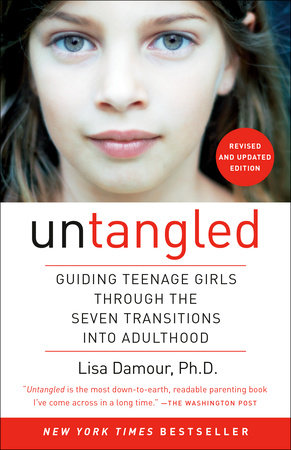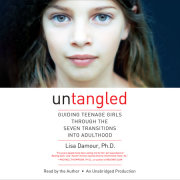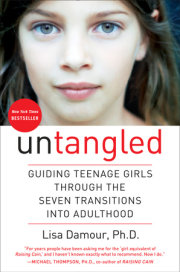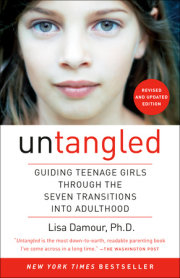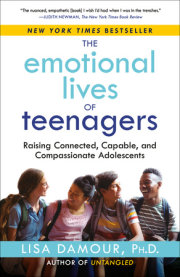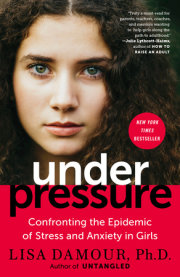one
Parting with Childhood
In the waiting room of my private practice, I met Maya for the first time. With an easy air, long limbs, and dark hair showing the beginnings of gray, she stood to greet me, then gracefully pivoted to return the magazine she’d been reading to its place on a low table, next to a lamp. She followed me to my office and took the far end of my couch. It’s not the closest spot to the armchair where I sit, but not so far away as a chair preferred by clients who want more distance. She kept her light jacket on—we were meeting on a crisp, sunny day in late October—and crossed her legs, clasped her hands, and leaned forward as we talked.
Over the phone, Maya told me that she was worried about the sudden change in her relationship with her twelve-year old daughter, Camille. In my office, she told a familiar story— one that we’ll consider in a totally new light.
Maya explained that until two months ago, Camille had been her funny, joyful companion who was almost always up for a trip to the library, grocery store, or mall. Yet at the start of seventh grade, Camille abruptly transformed. She came home from school and headed straight to her bedroom, where she closed the door and held marathon texting sessions with friends until required to join the family for dinner. Bewildered, Maya described how Camille sat sullenly at the dinner table and gave one-word answers to questions about her day. Even while saying so little, Camille managed to express that her parents were asking the dumbest questions she had ever heard and that sitting with them was the last thing she wanted to do.
Occasionally, the old Camille made a brief appearance; Maya’s eyes brimmed with tears as she described these savored moments. Most of the time, though, Maya felt angry with Camille for being so prickly, missed her warm relationship with her beloved girl, or experienced a wearying mix of both feelings at once. Maya’s friends reassured her that Camille was “normal” and that “girls break up with their parents when they become teenagers,” but Maya had called me anyway. She worried that something just wasn’t right.
Maya’s friends weren’t wrong, but their scope was too narrow and their viewpoint far too personal. They were missing the bigger picture. Girls don’t dump their parents just for the heck of it. They pull away to start their journey along one of the seven developmental strands of adolescence: parting with childhood. By age twelve most tweens feel a sudden, internal pressure to separate themselves from almost everything that seems childlike and, as Maya was learning the hard way, a girl’s pleasant relationship with her folks is usually one of the first casualties. Parting with childhood isn’t always the first developmental strand that girls tackle during adolescence, but it’s a strand that parents can’t miss. When girls distance themselves from their mom and dad they all but announce, “In case you guys hadn’t noticed, I’m a teenager now!”
If we step back from what feels like a highly personal rejection, we can appreciate that, when it comes to parting with childhood, our daughters have a lot of developmental ground to cover in a short time. They have to get from point A, where they happily hold our hands and act like total goofballs in public, to point B, where they claim the independence and self-determination that come with being young women and trade their goofiness for relatively mature behavior (at least when strangers are around). To progress along this strand, girls stop telling us their secrets, bristle when we use pet names, and make it clear that they’re doing us a favor by agreeing to join the family holiday picture. But a girl’s journey away from childhood isn’t all about her relationship with her parents. She might also experiment with makeup, suddenly insist that riding the school bus is for babies, and curse when with her friends.
Girls’ efforts to part with childhood are both conscious and not. Young teens admire older teens and fervently wish to be like them. I have my own ninth-grade flashbulb memory of watching a group of twelfth-grade girls, dressed in Madonna’s mid-’80s style, as they danced and lip-synced to “Borderline” during a talent show. They were beyond cool, and I remember resolving, in that moment, to close the gap between their lace gloved sophistication and my newly realized dorkiness. But a lot goes on behind the scenes in the unconscious mind, too. Even though they might not be aware of it, twelve-year-olds do the math and realize that, if all goes according to plan, they will be leaving home in five or six years. They suddenly feel pressed to prepare for adult independence by ridding themselves of the marks of childhood.
Maya had come to my office because she was worried that something was really wrong, and it’s my job to take parents’ concerns seriously. So I began to ask the questions that help me to know what was normal about Camille’s behavior, and what wasn’t: Was she rude to all adults, or just to her mom and dad? How were things at school and with her friends? Did she have interests, sleep well, and talk about what she wanted to do over the summer or next year?
Maya filled in the picture.
Teachers went out of their way to comment on Camille’s kind and conscientious nature. Camille dog-sat for the neighbors, and Maya heard the same about her from them. Maya explained that her daughter did well in school, had solid friendships, and spent hours each weekend on the family’s unfinished third floor, which she had turned into an elaborate apartment for her dolls. And though Maya suspected that she sometimes snuck her phone into her room for nighttime use, Camille usually slept well. She looked forward to going to camp each summer and also talked about her faraway goals to become a teacher or a scientist.
I reassured Maya that her friends were probably right—that her daughter’s prickly behavior
was normal. Then I encouraged her to see the change in Camille from a new perspective: there were seven transitions she would be making as she journeyed toward adulthood, and parting with childhood was one of them. Camille was doing exactly what we expect—even want—teenagers to do. And she was doing what they have done at least since 1958, when Anna Freud noted that the typical teenager lives “in the home in the attitude of a boarder, usually a very inconsiderate one so far as the older and younger family members are concerned.” Despite the fact that it has long been normal for teenagers to hold their parents at arm’s length, most of us feel rocked by the seismic shift in our relationship with our daughter.
You’ll notice that Anna Freud’s wisdom appears throughout this book; there are two reasons for this. First, she holds a special place in the history of psychology for being among the first to articulate, and
normalize, many of the predictable challenges that unfold during adolescence. Needless to say, this book aims to build upon that fine tradition. Second, she holds a special place in my heart because she played a small role in my decision to become a psychologist.
When I was six years old, my father’s work for an American bank transferred us from Denver to London for a few years and, by coincidence, a family friend made the same move in the same week. Carla, a reedy graduate student with a mane of wavy red hair, was headed to London to study with Anna Freud. My parents essentially adopted Carla, and she looked after me, their only child, over long weekends when they traveled together. Carla lived in north London, near Anna Freud’s training clinic, in a tiny flat consisting of a living room, a miniature mid-1970s British kitchen, a cramped bathroom, and a bedroom that was overwhelmed by the queen-sized bed we shared when I stayed over. The radiator in the kitchen ran on coins, and it soon became part of our weekend routine. Carla would save up pence between my visits and let me drop them into the radiator’s slot when I arrived. Then we’d sit in her kitchen and I’d start with my questions: “What brings the children to therapy? What do you say to them? What do they say to you? How does all that talking help them get better?” Carla was incredibly patient and generous with me. Replaying our conversations in my mind, I can hear how fully she addressed my curiosity about her work, even as she pitched her answers to a six-year-old.
I was hooked. Shortly after I turned seven, I walked into our London flat and announced to my mother, “I want to do what Carla does.” Nearly forty years later, Carla remains a close friend and mentor, and I remain grateful that she introduced me to a career that I have found deeply gratifying, both professionally and personally.
Copyright © 2016 by Lisa Damour, Ph.D.. All rights reserved. No part of this excerpt may be reproduced or reprinted without permission in writing from the publisher.

